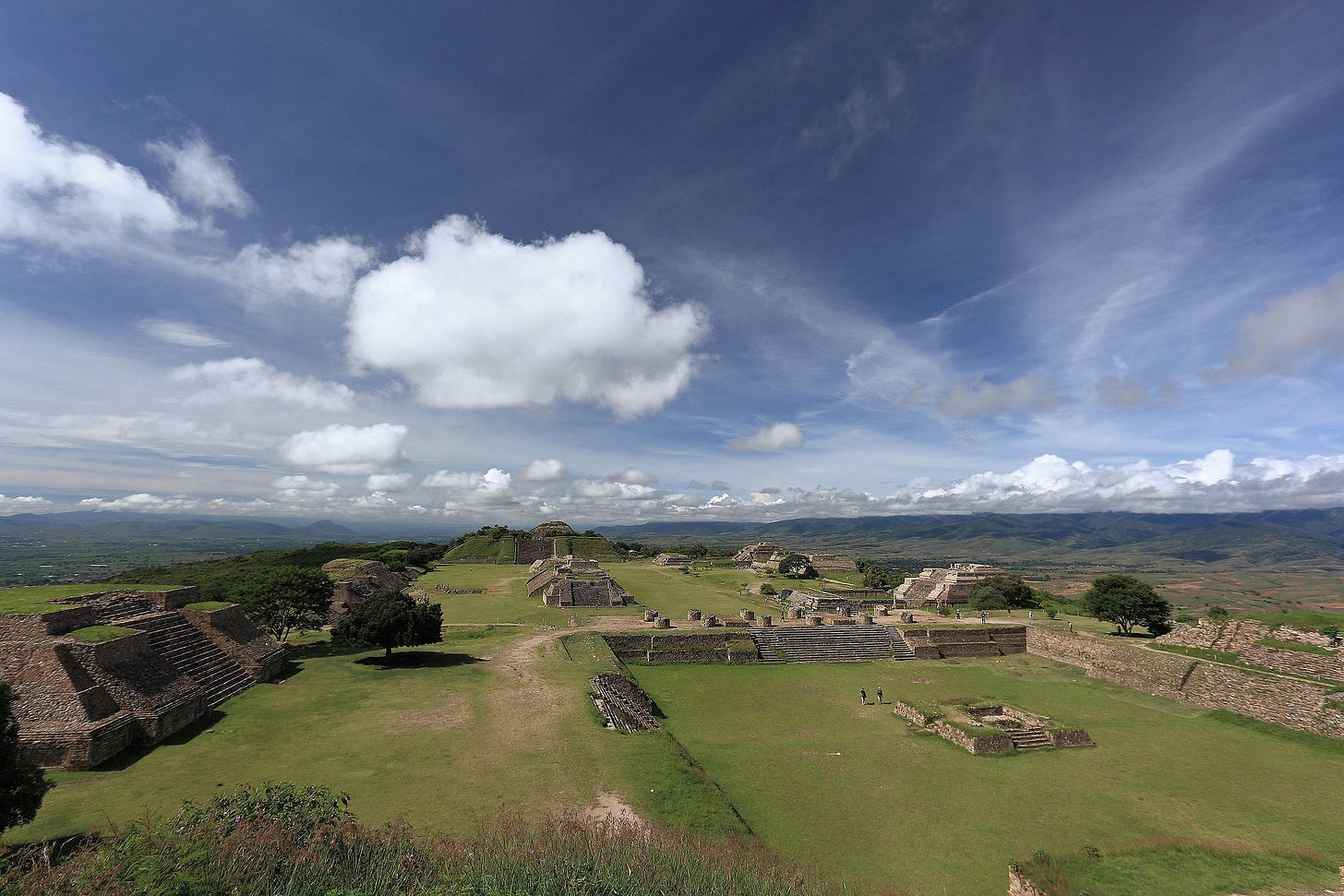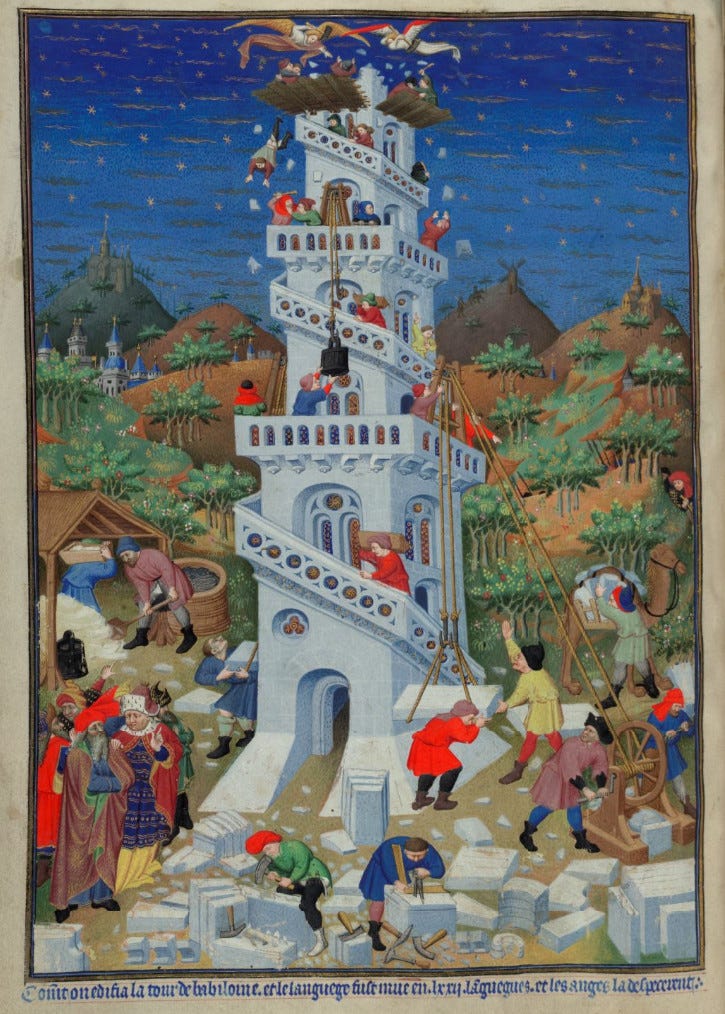2030 and Beyond: Are the end times coming, again?
Gleanings from Peter Turchin and Gaya Harrington (and G.K. Chesterton)
For those of you who prefer to read off paper rather than the screen, I have converted the post into an easily printable pdf file:
If there is one fact we really can prove, from the history that we really do know, it is that despotism can be a development, often a late development and very often indeed the end of societies that have been highly democratic. A despotism may almost be defined as a tired democracy. As fatigue falls on a community, the citizens are less inclined for that eternal vigilance which has truly been called the price of liberty; and they preferred to arm only one single sentinel to watch the city while they sleep.
– G.K. Chesterton, The Everlasting Man
“I can’t live here anymore. I have to take my family somewhere else.”
I know Hector from a Protestant church where I have friends. He’s a father, a Latino, a software engineer, and more than anything, God-fearing.
Which is to say he’s a big-chested conservative, the kind that can make progressives uncomfortable. But I’d trust him with my life, which I couldn’t say about most people I know.
Hector is moving away, hundreds of miles away to a less populated region in the American Bible belt, where he believes life will be more stable for his family, and a safer place to be when—he believes—society collapses.
Hector sees the signs of the coming collapse everywhere, such as the widening divisions between the political left and right—which we all see, of course. But Hector also sees it in the kinds of things conservatives tend to be most concerned about, like increasing government control, the demise of traditional values, and in the tendency for Westerners to loathe their historical identity but to indulge themselves in the harvest of its accomplishments. The foundations of society are getting fragmented, and a collapse is coming—Hector is pretty sure about that.
And while you might disagree with his personal values, Hector isn’t the only one who believes that we’re on the brink.
The musical chairs problem
Peter Turchin and his team have used mathematics to study the collapse of past societies, and he’s also written a book on the subject called End Times. According to Turchin, a major cause of the breakdown of civilizations—in fact, the major cause—is the “overproduction of elites”.
Elites are people with wealth, status, or other forms of power. The problem isn’t so much that elites exist, but that societies get to a point where too many elites are aspiring for positions of power.
Turchin compares it to a game of musical chairs. Imagine there are 10 chairs and 11 people. The music starts and everybody circles around and then the music stops. Everybody sits down—everybody but one. That’s how the game goes.
But Turchin asks us to imagine what would happen if instead of 11 people in the game, there were 15 people, or 20, or 30, but still only 10 chairs. When the music stops it gets harder to find a seat because there are so many people vying for so few chairs. So what do they do?
They start shoving each other. They start breaking the rules. What used to be a well-functioning game becomes dysfunctional, and according to Turchin the same thing can happen to a society when too many elites are vying for too few positions of power. Corruption sets in.
The overproduction of elites also creates what Turchin calls a wealth pump, in which increasing amounts of wealth move to the top of society, while ordinary people are left with less. For instance, the average American paycheck has been mostly stagnant for the past 40 years in terms of real buying power, while the buying power of people in higher income brackets has increased.
As the living standard of ordinary people goes down, the chances of societal collapse goes up.
A final factor that tends to increase the chances of collapse is a decline in the ability of a state to function. The state can’t deal with problems as effectively as in the past—as the ruling elites aren’t doing a good job anymore—and people may start to question its legitimacy.
Then frustration sets in. Polarization. Social conflict.
At this point, the society is extremely vulnerable, which means all it might take is a crisis or multiple crises to trigger a collapse. Famine, pandemic, ecological shock, violent protest, assassination—or any other big stressors.
So why don’t the elites do something when they see things getting bad? According to Turchin, one problem is that elites tend to want to hold onto their wealth, power and social privilege, and maintain the status quo, even while conditions are deteriorating. But that only worsens the situation.
There’s another thing we tend to overlook. The non-elites—the average citizens with no great power—often assume that to make society better we need to move it in the correct political direction. A Republican believes society gets better if it moves in a more conservative direction, and a Democrat believes society gets better if it moves in a more liberal or progressive direction. Certainly, specific policies matter. Meaningful change can happen at this level.
But ordinary people can get so focused on whether politics moves horizontally to the left or to the right, that they forget the vertical direction: whether power moves up toward the elites, or down toward the common citizen.
Or else, if they don’t forget, they assume that elite power is largely a problem in one political party or system, when in reality it is a problem of human nature. The desire to have special power or status is as perennial as ancient oligarchies and modern schoolyard cliques, and is no less ravenous in the heart of the Marxist than the fascist—or in ourselves.
Following Turchin’s logic, whether a society can survive under stress over the long run depends more on an imbalance in this vertical direction, when too much power is concentrated in the hands of too few, than on an imbalance in the horizontal direction.
“In the United States the ruling elites have a globalist ideology because it is incredibly lucrative for them.” – Peter Turchin
The story of Monte Albán
In his classic book The Everlasting Man, G.K. Chesterton makes this observation about democracy:
It is far more probable that a primitive society was something like a pure democracy. To this day the comparatively simple agricultural communities are by far the purest democracies. Democracy is a thing which is always breaking down through the complexity of civilization.
It’s a brilliant insight, as we might naturally think the opposite—that more advanced or modern civilizations lead to the “spread” of democracy, rather than to interfere with it. Yet it may well be that political equality is more likely to be found in smaller and simpler societies.
Consider Monte Albán. The ancient Mesoamerican city, located on a hilltop in the Oaxaca valley in southern Mexico, was the administrative and religious capital of the Zapotec people. At its peak the city had 17,000 inhabitants, and its architecture boasted pyramids, a ballgame court, and residential districts built on terraces with shared retaining walls, with drainage channels to divert rainwater. Some of these wonders are still visible in the ruins today.
Monte Albán was founded around 500 BC and lasted until around 800 AD, at which point it experienced a collapse. The area around the city was arid, and droughts happened periodically, so it wasn’t situated on the most fertile land. But that isn’t why it collapsed. In fact, despite the higher risk of crop failure, and probably higher taxes, there’s evidence that people actually moved there from other regions, and that the health and nutrition of the residents was better than in other Mesoamerican settlements. So what happened?
Monte Albán was a tight-knit and politically non-autocratic society for much of it’s 1300-year history:
People not only lived very close together, but they also must have been highly cooperative from one domestic unit to another, because if part of the retaining wall collapsed or the drain got clogged, they'd have to work together to fix it…Compared to more autocratic societies, like the Classic-period Maya, Monte Albán seems to have had a more collective form of governance.
In the earlier years of Monte Albán’s history, there wasn’t much indication of highly personalized power. No rich tombs, no evidence of extreme wealth differences, no large ornate palaces to indicate a ruler’s residence. The size differences between elite versus non-elite residences was fairly small.
But toward the end of its history, elite homes became larger, and the personalized iconography of rulers became more prominent. Around the same time, Monte Albán’s population declined and its monumental building projects diminished. The city was ultimately partially abandoned.
Initially it was believed that the collapse of this once-thriving city was due to ecological disaster or maybe war, and it’s certainly possible that such external stressors were present—like needles poking at the balloon of civilization. But the decline in the city’s population doesn’t seem to have been due to death.
Instead, the evidence suggests that people started leaving the city, while in the meantime the population of surrounding settlements increased. In Peter Turchin’s view, the out-migration was caused by growing inequality in the city, which brought with it reduced well-being, political polarization, and diminished social cohesion.
Essentially, residents “voted with their feet”.
Which is a bit like my friend, Hector, who is moving away to what he believes to be a safer region, where he can survive and thrive if there’s a collapse. Hector is voting with his feet.
How many others will vote with their feet in the coming years?
Small is good
When we hear about a place like Monte Albán, we might think, Why can’t we be more like that? Why can’t we be tightknit and non-autocratic?
As I mentioned in a recent post, not so long ago I became a naturalized Swiss citizen. Most of my reasons were family-related, but beyond that, one of the things I’ve always admired about the Swiss is that their society emphasizes small, local community, and their political system is highly referendum-based. Ordinary citizens get to vote on actual legislation. You also never hear about the Swiss president, because there are seven of them, and each one serves only for a year. Political elites exist, but the power differentials between them and the ordinary voting citizen is much smaller.
So, while Monte Albán was in many ways unique, some of the principles underlying its social cohesion—especially a more equal dispersion of political power—can still be seen, rarely, even today. But whether these principles can be implemented on a wider population scale to avert a societal collapse is unclear. We might also be running out of time.
According to Turchin, America has come close to collapse twice, first during the Civil War (1861-1865), and again during the Great Depression (the 1930s). Most commonly, collapse, or some form of “disintegration”, happens at the end of 100-year cycles, so by that count, we’re right on track for another one. And Turchin isn’t the only one who’s made this prediction.
2030 and beyond
A few years ago researcher Gaya Harrington did an update of a 1972 study called the Limits to Growth. The 1972 study concluded that if humanity kept pursuing economic growth without regard for environmental and social costs, global society would experience a sharp decline during the current century.
Harrington’s updated study examined various scenarios, each with different assumptions, to see what they would predict about our future. Two of these scenarios fit the data best; these two are the ones that seem to track our current trajectory.
Unfortunately both scenarios predict a halt in welfare, food, and industrial output by approximately 2030, and then a decline. But how much decline?
Here are the two scenarios, and the two possible outcomes they predict:
Business as Usual x 2 (BAU2): This scenario assumes that society keeps chugging along as it always has (“business as usual”), but has double the amount of natural resources it originally thought it had. Nevertheless, despite the added resources, society collapses.
Comprehensive Technology (CT): This scenario is the same as the one above, except it includes one more advantage: new technologies are developed to help avert a collapse. As a result, society does not fall hard; it declines, yet with a softer and less devastating landing.
So, the Comprehensive Technology scenario isn’t perfect, but it does predict a better outcome. However, in order for this outcome to happen, according to Harrington, we must find technological solutions to a host of problems we face—climate, agriculture, energy, and so on—and we need to do it quickly.
For example, one of the problems we face is a shrinking population, which will lead to a smaller workforce and labor shortages. How can technology help? Enter the robots, who are already making everything from cars to French fries. As tech writer
has pointed out, more sophisticated robots known as “physical AI” or “humanoids” are on their way, and they won’t just be able to think and talk like AI, but will carry out physical tasks in our workspaces and homes.As I’ve said before, I’m not anti-technology, but rapidly unleashing new technologies on society brings with it the risk of unpredictable consequences. Yet that’s only part of the problem. The other part is this: Who will be in control of these technologies?
Probably the elites that Peter Turchin keeps warning us about.
For example, consider the humanoids. It might sound cool to have sleek robots efficiently managing our warehouses and grinding coffee beans in our kitchens each morning while we’re busy taking a shower, but these machines, like our phones and laptops, will have an operating system that is monitored and updated remotely. This same remote access, though, could give a government or corporation the power to use those humanoids, if necessary, for social control. Did you say something politically or socially offensive? Are you going downtown to join a protest? That cool machine that slavishly obeys your orders might also have the power to intimidate you or disconnect the on-button in your electric car.
This problem isn’t limited to humanoids, but to any new technology that gives political elites greater power to monitor, record, analyze, or manipulate society. Again, the problem here isn’t technology itself, but the increased concentration of power it will give to ruling elites, which could leave significant portions of the population feeling frustrated and erode social cohesion. It could also worsen conflict between elites in their striving for supremacy.
So we’ve got a contradiction. To prevent the collapse of society, one expert (Harrington) argues for rapid technological development, which will invariably give more power to governing elites, while another expert (Turchin) argues that concentrating too much power in the elites increases the chances of a collapse.
And that isn’t the only contradiction.
The “stabilized world” (which might not be stable)
There is another scenario that Harrington describes. This scenario doesn’t look very likely to happen based on the current data, but in Harrington’s view, it does result in a future outcome in which societal collapse is avoided.
Harrington calls this scenario the Stabilized World (SW). This scenario is just like Comprehensive Technology—it includes rapid technological development—but it also involves one more ingredient: a major shift in our societal values and priorities.
Which values and priorities do we need to change?
A change in values and policies translates into, amongst other things, low desired family size, perfect birth control availability, and a deliberate choice to limit industrial output and prioritize health and education services.
Of course, not everybody will agree with all the values that Harrington mentions, which brings us to the problem. Who decides which values are best?
It doesn’t help to say “the data” decide, since the data, after all, are based on modeling assumptions, and assumptions can vary from person to person. This isn’t to suggest that assumptions are arbitrary and that the data are meaningless, but applied sciences are not without bias. If a devout Christian, Muslim, or Jew had carried out Harrington’s modeling, I’m not so sure they would have arrived at the same conclusions as Harrington about family size, abortion, and other social values.
So again, who decides?
It seems we’re back to Peter Turchin’s elites, and back to another contradiction. To prevent the collapse of society, one expert (Harrington) argues for a major global realignment of our values, which will invariably be managed and controlled by our governing elites, while another expert (Turchin) argues that concentrating too much power in the elites increases the chances of a collapse.
Maybe it’s time for Gaya Harrington and Peter Turchin to talk?
The collapse of hyper-order
When we think about collapse, we tend to think about it in terms of disintegration or disorder. Things break down, like a structure of building blocks getting knocked over. But this isn’t the only type of “collapse”.
There is a second type of collapse, where instead of getting knocked over, the blocks begin to tighten up, like the walls closing in around the people who live in that society.
An example would be a technological system where everybody is observed and monitored, and behaviors are micro-managed by increasing numbers of rules and prescriptive values, with punishments for those who don’t comply. This is not a collapse of disorder, but the opposite: a collapse of hyper-order, one that over-regulates individual human life.
If we follow Gaya Harrington’s path and rapidly impose new technologies and realigned values on society, we might save ourselves from a collapse of disorder, yet at the risk of increasing hyper-order.
If the balance tips too far in the direction of technological and values control—if ordinary citizens feel as if their behavior is being controlled by distant elites through the vast techno-ideological machinery of the state—the result could be frustration, division, instability. And so we’re back to a risk of disorder.
Either way, we may be facing a very fine balance in the coming years.
Nobody can predict with any real certainty if we’ll soon enter a period of collapse. There’s also a danger the idea of collapse can become a self-fulfilling prophecy, or else fuel paranoid or conspiratorial thinking.
Meanwhile, Christians might wonder if the next collapse will be not just another societal collapse, but the final apocalyptic end as described in the Bible. But who can really know? Jesus himself reminds us “of that day and hour no one knows, not even the angels of heaven, but My Father only”. And trying to decode the Bible’s apocalyptic passages by pure logic can produce weird results, which prompted Chesterton to remark: “Though St. John the Evangelist saw many strange monsters in his vision, he saw no creature so wild as one of his own commentators.”
So we can’t know those things, and trying to know them can twist us out of shape. It’s unhealthy to fixate on the day the world will end, as much as it is to predict the day we will die. Whether the next collapse is the final one or not matters less than how we respond to it.
It might be better to think of “collapse” in terms of normal periods of historical change which, although difficult, even calamitous, aren’t all negative. Collapses, Turchin reminds us, can be adaptive, as they replace vulnerable societies with more resilient ones.
Still, getting over the hump, if it comes, will be the hard part: the uncertainty, the upheaval, fears for our children.
Some like Hector and the residents of Monte Albán around 800 AD will respond by pulling up roots and voting with their feet—assuming there is somewhere else to go.
We’ll each have to find our own way to adapt if the upheaval comes to us; yet one thing we can do, ahead of time, is strengthen our families and local relationships. To create pockets of social cohesion that will give us cover if the wider fabric unravels.
Because if it unravels, it won’t be the elites who show up to save us. It will be the people around us who we can trust.
Thanks for reading! Comments are closed but if you enjoyed this article give a like or restack, or restack with a note to share your thoughts.












